Briefly: In our opinion, short (full) speculative positions in gold, silver and mining stocks are justified from the risk/reward point of view.
Mining stocks ended last week with a rally, which appears to be a very bullish development as they broke above the declining resistance line and this time the move above it was quite visible. Was this really the case or is the support reached in case of the USD Index more important at this time? There are many other factors that one should consider before making the final judgment. Let’s move right into charts (charts courtesy of http://stockcharts.com).
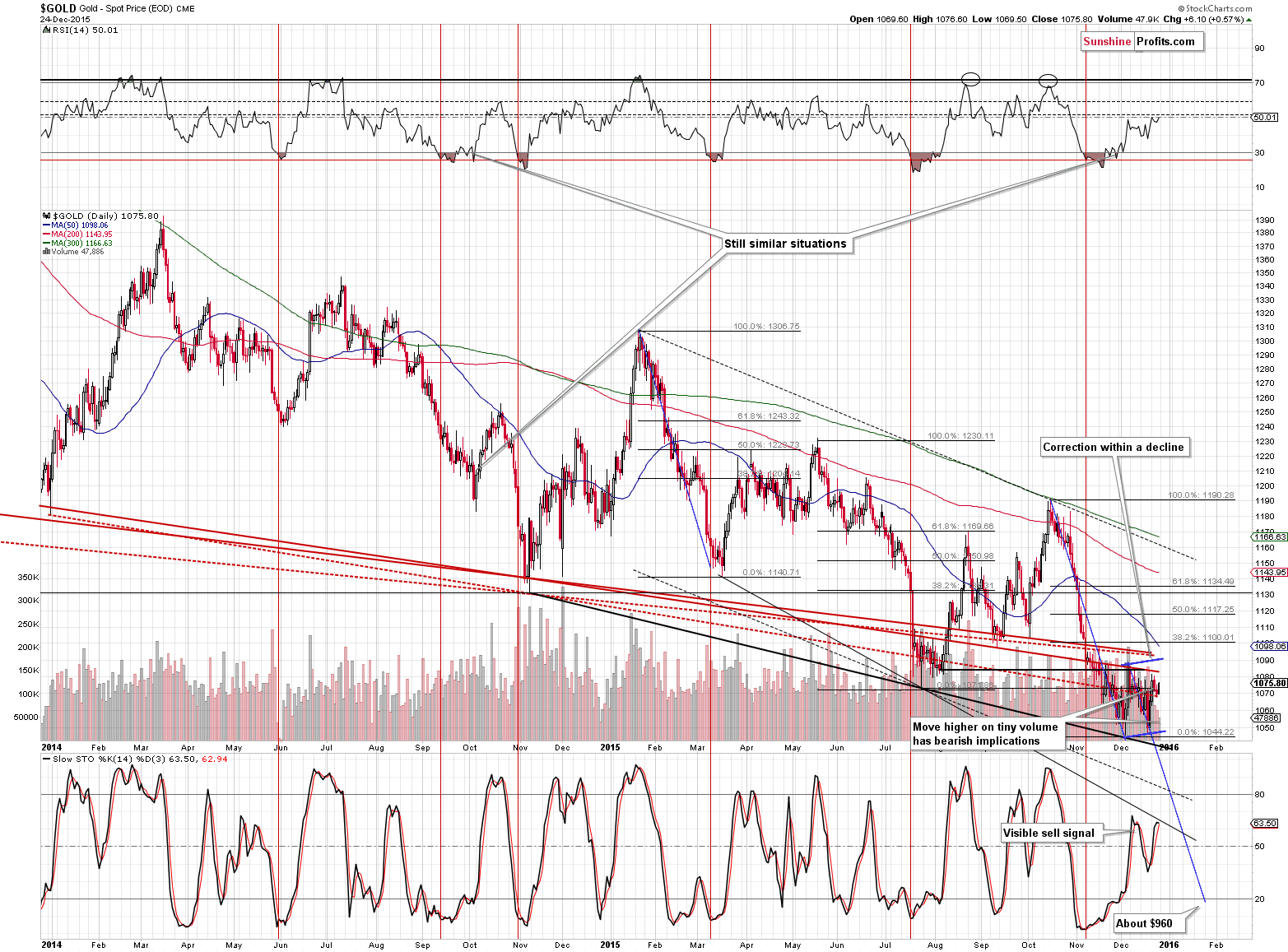
The situation on the short-term gold chart didn’t change last week. The trend remains down and we are seeing a consolidation within it. In terms of daily closing prices gold is well below the July and August 2015 lows – there breakdown remains in place and implications are bearish.
Gold moved higher before closing the week but the corresponding volume was very low, so the session was not really bullish. In fact, we can likely say the opposite (it was not bearish to a great extent as the size of the volume was affected by early close – 1:45 PM on December 24).
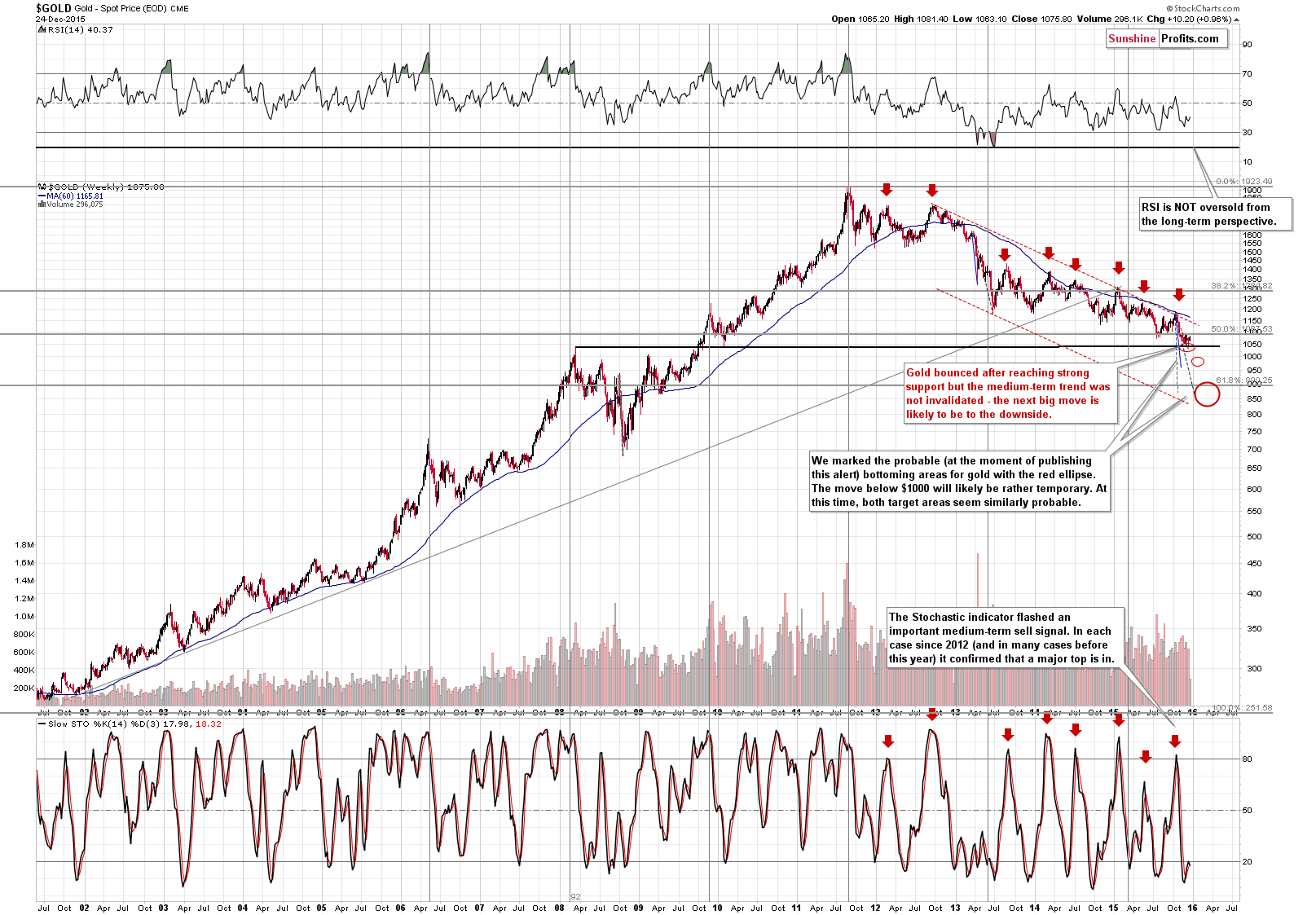
From the long-term perspective, not much changed – gold is still below the 50% Fibonacci retracement based on the entire bull market, the trend remains down, and gold is very close to its previous lows. In our opinion, the situation seems quite similar to what we saw 3 years ago – gold moved a bit higher after the initial bottom, but it turned out that it was actually a pause before a much bigger and much more significant slide lower.
Please note that we just saw a small sell sign from the weekly Stochastic indicator, which is bearish on its own and particularly bearish given the similarity to the final part of 2012.
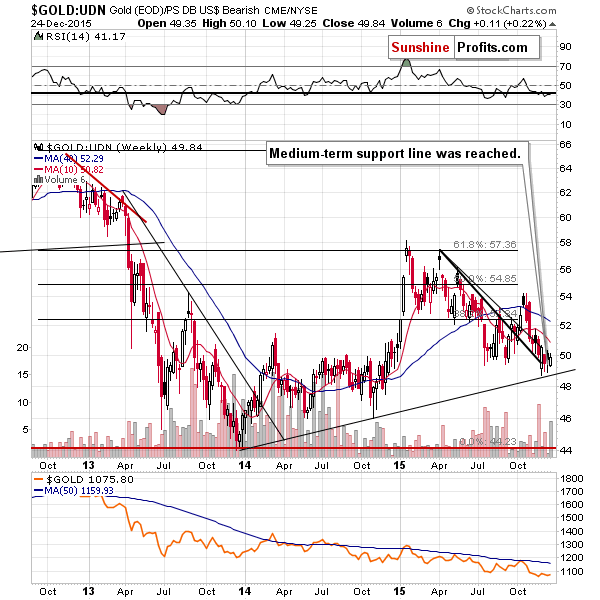
From the non-USD perspective (the average of gold prices in terms of currencies other than the USD) not much changed last week either. Gold moved a little higher, but the pause that we are currently seeing is not unexpected, as gold had previously moved to an important long-term support line. The medium-term trend remains down.
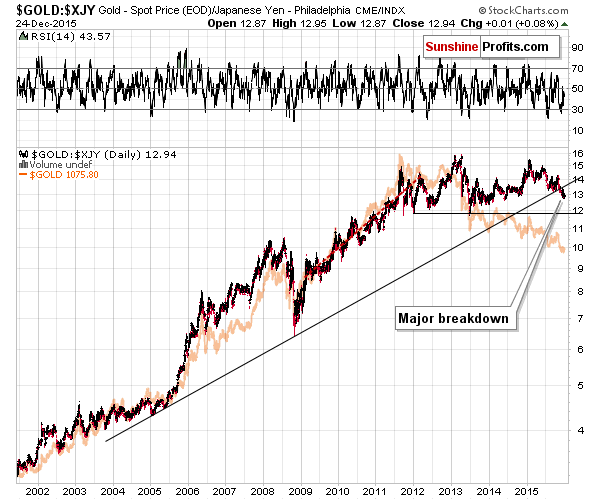
Gold seen from the Japanese yen perspective continues to have bearish implications – gold is after a major breakdown and before reaching another major support. This situation alone makes it likely that we will see lower prices. To be clear, this doesn’t tell us much about the very short term, but it does have very bearish implications for the following several weeks.
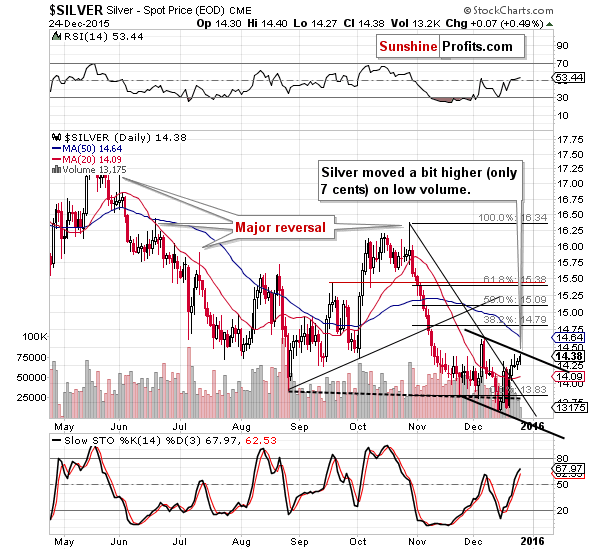
There were once again no changes in silver as the white metal moved only 7 cents higher. As it was the case with gold, the small move higher materialized on low volume and we think there were no bullish implications of this move.
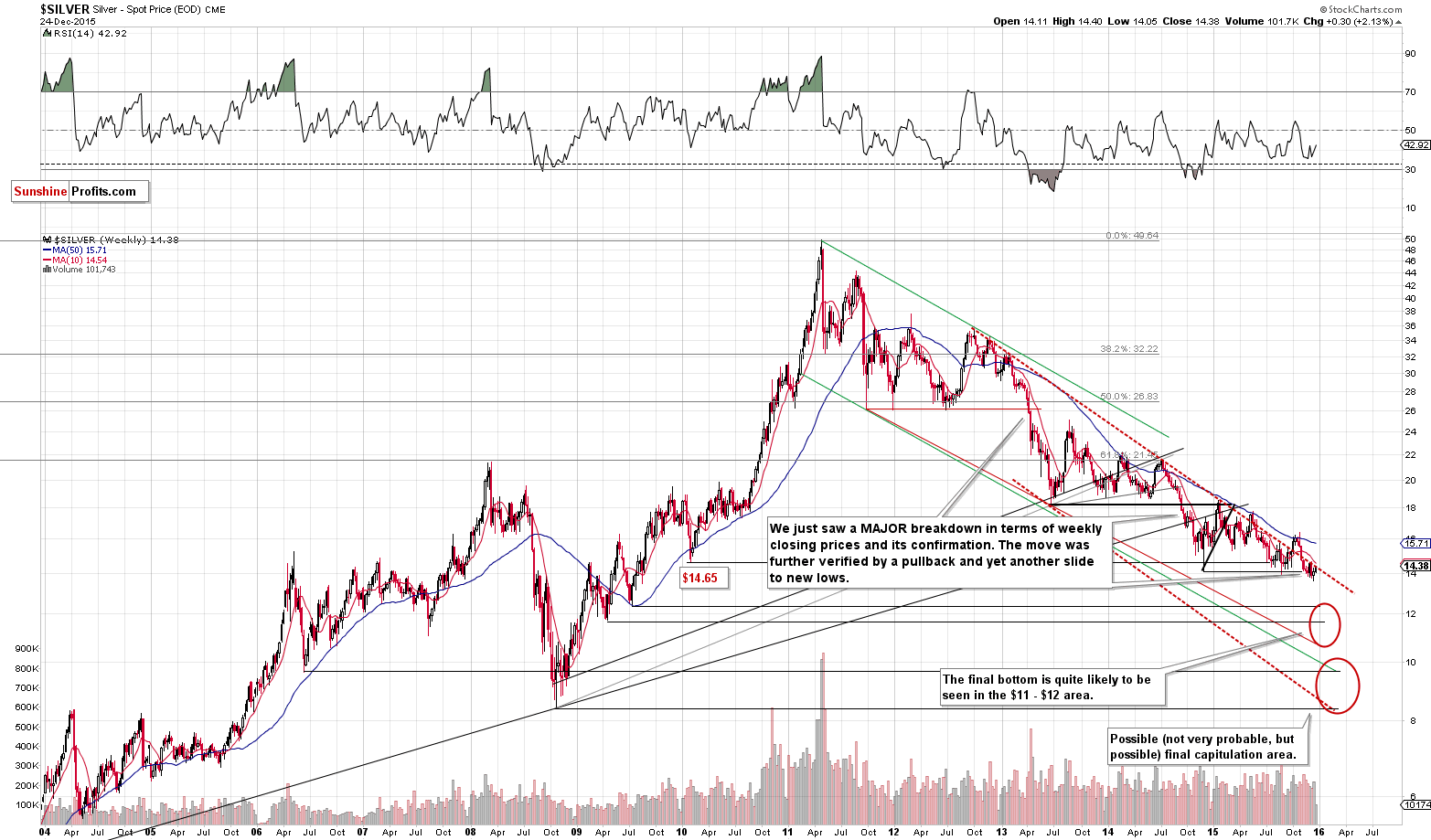
From the long-term perspective nothing changed either. Silver remains below the declining red resistance line and the medium-term trend remains down. Consequently, it’s likely that the next big move will be to the downside.
Since not much changed in silver, let’s move to the situation in mining stocks.
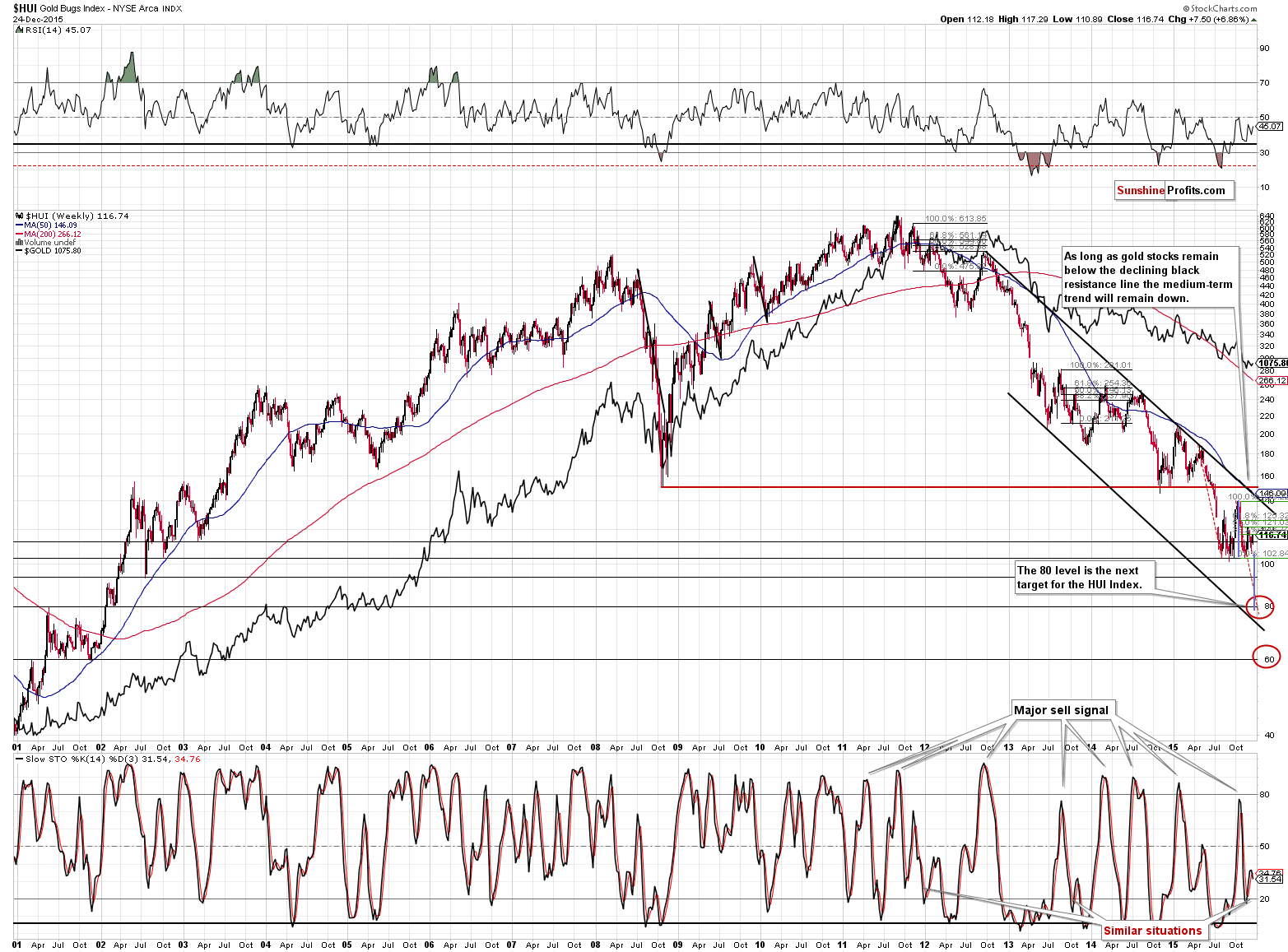
First of all, not much changed from the long-term perspective. Our comments from last Monday’s alert remain up-to-date:
The HUI Index (…) is about to create a bearish head-and-shoulders pattern. The target based on this formation is the 80 level, which was our next interim target anyway based on the early 2002 low and other calculations (the gold price target and the gold stocks to gold ratio analysis). Consequently, this target is even more likely to really hold the decline (at least for some time). Please note that there is also another level to which gold stocks could decline – the 60 level.
It seems unrealistic – we know – but did 106 seem realistic when the HUI was trading above 600 just a few years ago? The fundamental outlook for the precious metals market remains bullish in our view, but that doesn’t change anything (!) regarding the short term or even the medium term, given a strong downtrend. Markets are logical only in the long run, and emotional in the short run. Consequently, it is possible for the HUI Index to become even more oversold than it is right now before the final bottom is in.
The thing that has indeed changed is that we just saw a sell signal from the weekly Stochastic indicator. This is a very important (as it’s been a reliable sell signal numerous times in the past) and bearish development for the following weeks.
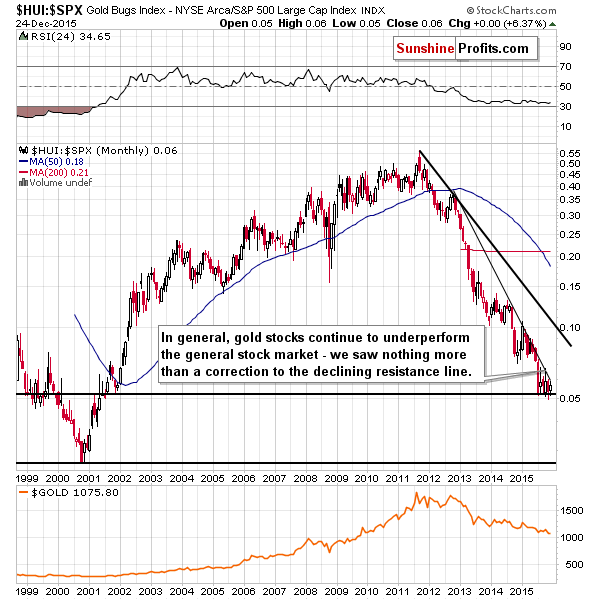
Comparing gold stocks to other stocks (the general stock market) shows that the major trend remains clearly down and that the time is almost out for the ratio to either break out above the declining resistance line or to break down below the late 2001 low and take another dive. In our opinion the latter is much more likely not only because of other bearish factors discussed in this alert, but also because the resistance created by the declining line is stronger than the support provided by a relatively small local low seen in late 2001.
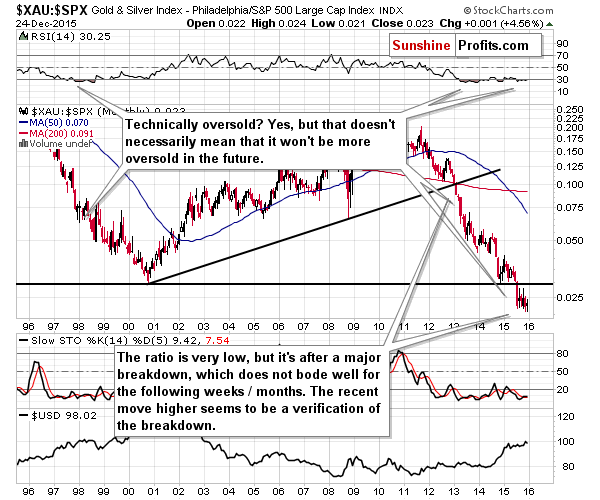
In case of another proxy for the mining stocks – the XAU Index – and its ratio with the general stock market we have already seen a breakdown below the 2000 low and its verification (a small move back to this level). The trend remains down and the implications remain bearish.
Now, what about the short-term picture?
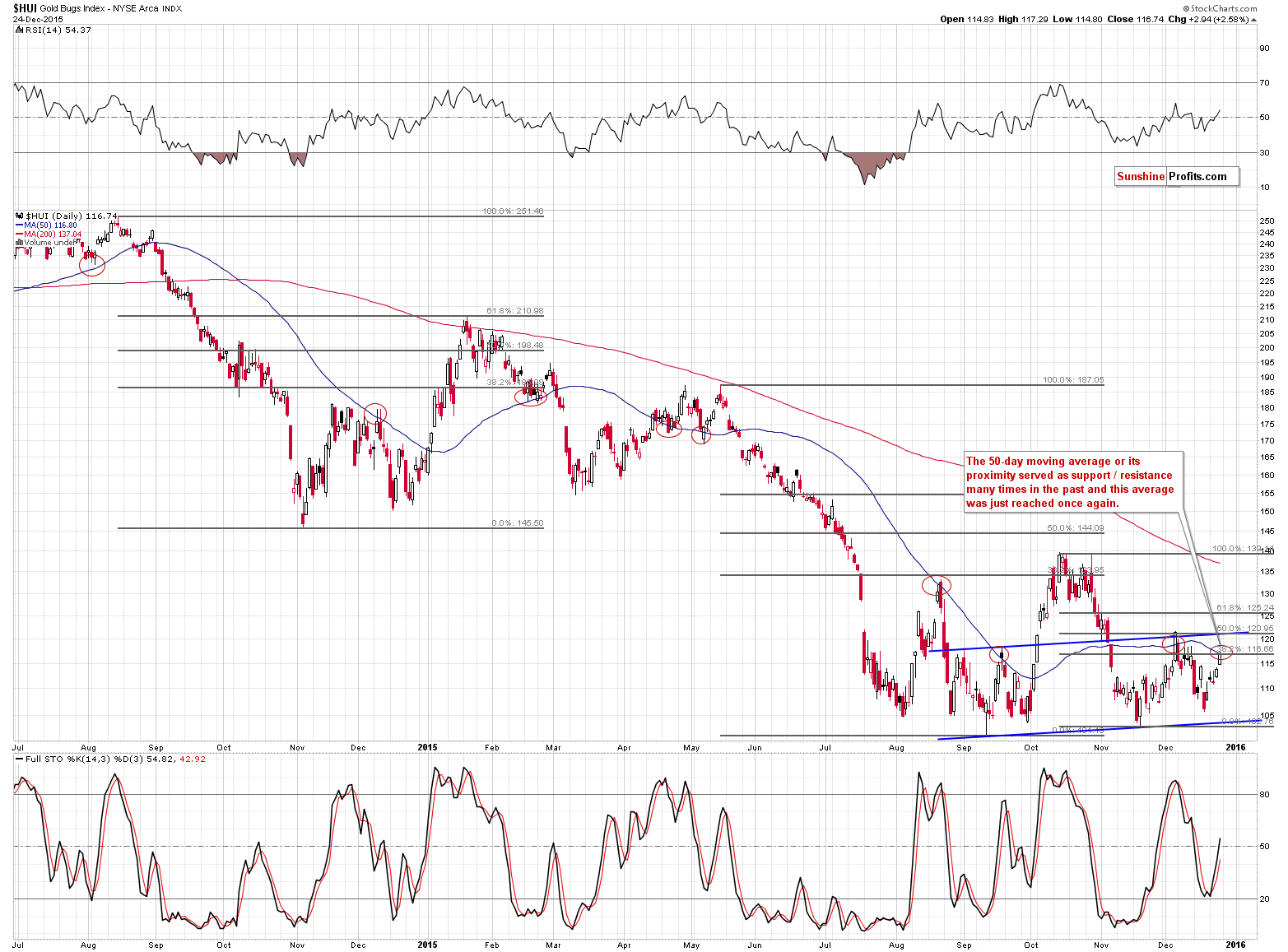
Much less changed than it seems to have been the case. Mining stocks moved higher last week, but they were stopped by the 50-day moving average – something that proved to be a reliable resistance and support many times in the past. Additionally, the level at which the HUI Index closed the week was the 38.2% Fibonacci retracement level. Consequently, from the technical perspective, not much really changed despite a move higher. In fact, even if the HUI Index moves to 120 level or so, still not much will change as it would only be a move to the previous local high and the 50% Fibonacci retracement. For a rally to invalidate the bearish outlook for the following weeks, we would have to see a confirmed breakout at least above 125 (the 61.8% Fibonacci retracement level).
We recently saw a buy signal from the Stochastic indicator, but its daily version is not really reliable (please note multiple fake signals before August).
As far as volume is concerned, the GDX ETF volume was low on Thursday, just like what we saw in case of gold and silver. Consequently, we don’t think the most recent move higher should be viewed as a true bullish signal.
On a side note, we received a few questions regarding the possible bearish formations in the DUST ETN and we believe the reply to these concerns is something that you would also appreciate. We think that DUST (or NUGT) should not be analyzed from the technical perspective at all. These instruments have significant time decay (which is caused by the way these instruments work – in short, let’s say that it’s the “price that traders pay” for the leverage), which distorts normal formations as it artificially lowers prices over time. The same goes for options for instance – you don’t see people analyzing charts of options’ prices because the price is affected to a great extent by the time decay factor. Why is this so important? Because the whole point of applying technical analysis is to detect similar situations in the past and apply them to the current events, because the markets move emotionally in the short- and medium term (and to some extent in the long term) and market participants tend to repeat their emotional reactions under similar circumstances (just like one would be scared each time seeing a bear charging toward them or excited when winning a lottery).
By analyzing price and volume we can detect what the market participants are likely to do – if what we analyze is based indeed on their emotions, not on a manipulative action of just one or a few market participants (although this too can be predicted if it occurs under similar circumstances) or if the price itself is not only affected by market participants, but something else. In case of instruments with significant time decay, like DUST or NUGT, the price moves are not only affected by what the market participants do (like it is the case with the HUI or XAU indices or the GDX ETF, which is a liquid instrument), but by the time decay. Consequently, a specific “drift” toward lower values does not necessarily reflect more bearish outlook, but may simply be reflection of how these leveraged instrument work. Therefore, price formations should be detected on the parts of the market that are not biased by the time decay factor (or where its minimal), such as the above-mentioned HUI, XAU or GDX.
While we’re at it, the above is also related to the reason due to which we don’t include individual mining stocks (which can be subject to company-specific moves and are not necessarily representing the entire market’s reaction) into our analysis and especially the individual junior mining stocks and companies that are trading on low volume (not only subject to company-specific events and risks, but also vulnerable to sudden moves due to either manipulative actions or simply large trade orders due to low volume and market capitalization – a large order can simply move the market and in this case the rally doesn’t necessarily represent a sudden increase in the overall expectations toward a particular company). In fact, sudden increases in prices of such thinly traded securities along with “normal” performance of the well-capitalized companies from the same sector quite often indicate a local top in a given market (you’ll find more similar trading tips on this page).
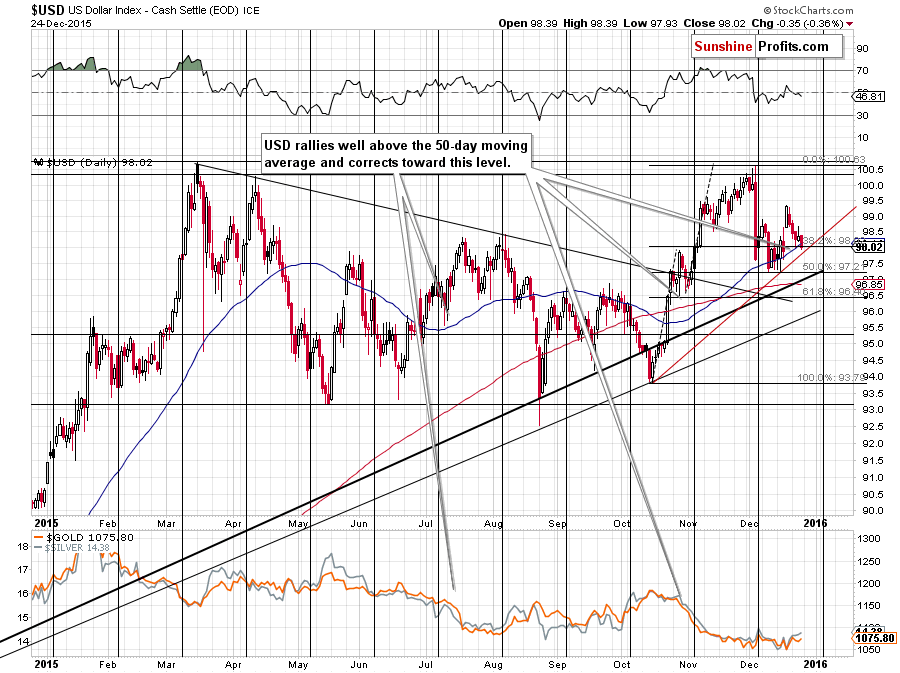
Before summarizing, we would like to comment on the situation in the USD Index, as in the past several days the precious metals sector moved in the opposite direction to the moves in this all-important index.
In the previous alert we wrote the following:
The USD Index is in a particularly interesting situation right now. It’s after the visible comeback above the 50-day moving average and it moved back to it. Breakouts above this average have been important events and confirmations of these moves were important s well. There were only 2 similar cases in the past year and in both cases a rally in USD Index followed.
More importantly, these were the times right before the start of a major plunge in the precious metals sector, so we have yet another bearish confirmation.
The USD Index moved once again lower, but didn’t move visibly below the 50-day moving average, the 38.2% Fibonacci retracement level and the index remains visibly above the rising support line. Based on the latter, the possible downside seems very limited. Consequently, it seems that the short-term upside for the precious metals sector is limited as well.
Before summarizing, we would like to point out that a few days ago there was an article posted on investing.com on gold and oil that was “based” (which is a polite way to describe it since the author didn’t mention us at all and even cut out our logo from the charts – please compare them to the original version) on our article that we posted 3 years ago. We are pointing this out to show you that in some cases there is a very big difference between reading only publicly available and at times re-used analyses and having a direct and fast access to an analysis of an important topic and reading about it quickly – in this case the time difference is 3 years and the scope of the analysis is much greater in case of reading the article signed directly by us. While we’re at it, we’ll likely expand and update the above-mentioned gold-oil analysis in the coming weeks.
Summing up, the mining stocks’ move higher in the final part of last week seems to have been bullish and important, but due to low volume and multiple resistance levels that were not broken this signal is not very strong in our opinion. It was not the only new signal that we saw last week – we also saw important sell signals from the weekly versions of the Stochastic indicator in case of gold and HUI Index, which actually made the medium-term outlook even more bearish. Overall, the situation didn’t change much last week and consequently, the outlook remains bearish.
In our opinion, we are in a similar situation to what we saw in mid-August 2014, in mid-June this year or in the final part of 2012. If the major move that is going to follow is to the downside then a daily or relatively small upswing is not that relevant - it’s most important not to miss the big move and thus the speculative short position seems to be justified from the risk/reward perspective. It seems that the current speculative short position in the precious metals sector will prove very profitable in the following weeks even if it will not the case for the next few days. After all, our target of $960 in gold is well below the current market price and if the analogy to the 2013 slide is indeed in place, then we will likely not have to wait long before this level is reached.
The upcoming year will likely start with major events in the precious metals world and paying extra attention to this market for the first few months should prove well worth it.
As always, we will keep you – our subscribers – updated.
To summarize:
Trading capital (our opinion): Short positions (full) in gold, silver and mining stocks are justified from the risk/reward perspective with the following stop-loss orders and initial target price levels:
- Gold: initial target price: $973; stop-loss: $1,107, initial target price for the DGLD ETN: $117.70; stop-loss for the DGLD ETN $81.84
- Silver: initial target price: $12.13; stop-loss: $14.83, initial target price for the DSLV ETN: $101.84; stop-loss for DSLV ETN $57.49
- Mining stocks (price levels for the GDX ETF): initial target price: $10.23; stop-loss: $15.47, initial target price for the DUST ETF: $31.90; stop-loss for the DUST ETF $10.61
In case one wants to bet on junior mining stocks' prices (we do not suggest doing so – we think senior mining stocks are more predictable in the case of short-term trades – if one wants to do it anyway, we provide the details), here are the stop-loss details and initial target prices:
- GDXJ ETF: initial target price: $15.23; stop-loss: $21.13
- JDST ETF: initial target price: $52.99; stop-loss: $21.59
Long-term capital (our opinion): No positions
Insurance capital (our opinion): Full position
Plus, you might want to read why our stop-loss orders are usually relatively far from the current price.
Please note that a full position doesn’t mean using all of the capital for a given trade. You will find details on our thoughts on gold portfolio structuring in the Key Insights section on our website.
As a reminder – “initial target price” means exactly that – an “initial” one, it’s not a price level at which we suggest closing positions. If this becomes the case (like it did in the previous trade) we will refer to these levels as levels of exit orders (exactly as we’ve done previously). Stop-loss levels, however, are naturally not “initial”, but something that, in our opinion, might be entered as an order.
Since it is impossible to synchronize target prices and stop-loss levels for all the ETFs and ETNs with the main markets that we provide these levels for (gold, silver and mining stocks – the GDX ETF), the stop-loss levels and target prices for other ETNs and ETF (among other: UGLD, DGLD, USLV, DSLV, NUGT, DUST, JNUG, JDST) are provided as supplementary, and not as “final”. This means that if a stop-loss or a target level is reached for any of the “additional instruments” (DGLD for instance), but not for the “main instrument” (gold in this case), we will view positions in both gold and DGLD as still open and the stop-loss for DGLD would have to be moved lower. On the other hand, if gold moves to a stop-loss level but DGLD doesn’t, then we will view both positions (in gold and DGLD) as closed. In other words, since it’s not possible to be 100% certain that each related instrument moves to a given level when the underlying instrument does, we can’t provide levels that would be binding. The levels that we do provide are our best estimate of the levels that will correspond to the levels in the underlying assets, but it will be the underlying assets that one will need to focus on regarding the sings pointing to closing a given position or keeping it open. We might adjust the levels in the “additional instruments” without adjusting the levels in the “main instruments”, which will simply mean that we have improved our estimation of these levels, not that we changed our outlook on the markets. We are already working on a tool that would update these levels on a daily basis for the most popular ETFs, ETNs and individual mining stocks.
Our preferred ways to invest in and to trade gold along with the reasoning can be found in the how to buy gold section. Additionally, our preferred ETFs and ETNs can be found in our Gold & Silver ETF Ranking.
As always, we'll keep you - our subscribers - updated should our views on the market change. We will continue to send out Gold & Silver Trading Alerts on each trading day and we will send additional Alerts whenever appropriate.
The trading position presented above is the netted version of positions based on subjective signals (opinion) from your Editor, and the Tools and Indicators.
As a reminder, Gold & Silver Trading Alerts are posted before or on each trading day (we usually post them before the opening bell, but we don't promise doing that each day). If there's anything urgent, we will send you an additional small alert before posting the main one.
=====
Latest Free Trading Alerts:
We wrote in August that the yields on the riskiest junk bonds had been rising. Since then, the situation has worsened. What does the selloff in the high-yield bond market mean for the U.S. economy and the price of gold?
The U.S. Junk Bond Market and Gold
The gold is a reflection of confidence in the U.S. economy. Thus, we take a closer look at the relationship between the gold market and consumer activity, the allegedly main driver of the U.S. economy. We invite you to read our today’s article on that important topic and learn more about the relationship between the price of gold and consumer reports, such as the Personal Income and Outlays and Retail Sales.
Do the Consumer Reports Drive the Gold Price?
S&P 500 index extends its medium-term consolidation. Which direction is next? Will it continue its recent move up? Or is this a short-term topping pattern?
Stock Trading Alert: No Clear Short-Term Direction - Topping Pattern?
=====
Hand-picked precious-metals-related links:
Gold drifts lower in thin liquidity
The Mystery Of Dubai's Vaporized Gold: The Plot Thickens
=====
In other news:
Treasuries Draw Weakest Demand Since '09 as Central Banks Unload
Federal Reserve will pay banks $12 billion in 2016
Chinese and Indian workers will get 8% and 10% pay bumps next year
=====
Thank you.
Sincerely,
Przemyslaw Radomski, CFA
Founder, Editor-in-chief
Gold & Silver Trading Alerts
Forex Trading Alerts
Oil Investment Updates
Oil Trading Alerts



